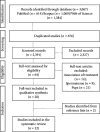Relevance of the Isoflavone Absorption and Testicular Function: A Systematic Review of Preclinical Evidence
- PMID: 33628321
- PMCID: PMC7895610
- DOI: 10.1155/2021/8853172
Relevance of the Isoflavone Absorption and Testicular Function: A Systematic Review of Preclinical Evidence
Abstract
Isoflavone is a phytoestrogen found in different types of food that can act as endocrine disrupters leading to testicular dysfunction. Currently, fragmented data on the action of this compound in the testicles make it difficult to assess its effects to define a safe dose. Thus, we systematically reviewed the preclinical evidence of the impact of isoflavone on testicular function. We also determined which form (aglycones or glycosylated) was the most used, which allowed us to understand the main biological processes involved in testicular function after isoflavone exposure. This systematic review was carried out according to the PRISMA guidelines using a structured search on the biomedical databases MEDLINE (PubMed), Scopus, and Web of Science, recovering and analyzing 22 original studies. The bias analysis and the quality of the studies were assessed by the criteria described in the risk of bias tool developed by SYRCLE (Systematic Review Centre for Laboratory Animal Experimentation). The aglycones and glycosylated isoflavones proved to be harmful to the reproductive health, and the glycosylates at doses of 50, 100, 146, 200, 300, 500, and 600 mg/kg, in addition to 190 and 1000 mg/L, appear to be even more harmful. The main testicular pathologies resulting from the use of isoflavones are associated with Leydig cells resulting from changes in molecular functions and cellular components. The most used isoflavone to evaluate testicular changes was the genistein/daidzein conjugate. The consumption of high doses of isoflavones promotes changes in the functioning of Leydig cells, inducing testicular changes and leading to infertility in murine models.
Copyright © 2021 Amanda Alves Lozi et al.
Conflict of interest statement
The authors declare no conflicts of interest.
Figures






Similar articles
-
Testicular development in male rats is sensitive to a soy-based diet in the neonatal period.Biol Reprod. 2014 Feb 27;90(2):40. doi: 10.1095/biolreprod.113.113787. Print 2014 Feb. Biol Reprod. 2014. PMID: 24451983 Free PMC article.
-
Bioavailability of pure isoflavones in healthy humans and analysis of commercial soy isoflavone supplements.J Nutr. 2001 Apr;131(4 Suppl):1362S-75S. doi: 10.1093/jn/131.4.1362S. J Nutr. 2001. PMID: 11285356
-
LC/UV/ESI-MS analysis of isoflavones in Edamame and Tofu soybeans.J Agric Food Chem. 2004 May 19;52(10):2763-9. doi: 10.1021/jf035053p. J Agric Food Chem. 2004. PMID: 15137811
-
Isoflavones alter male and female fertility in different development windows.Biomed Pharmacother. 2021 Aug;140:111448. doi: 10.1016/j.biopha.2021.111448. Epub 2021 Jun 12. Biomed Pharmacother. 2021. PMID: 34130202 Review.
-
Protective effects of melatonin against the toxic effects of environmental pollutants and heavy metals on testicular tissue: A systematic review and meta-analysis of animal studies.Front Endocrinol (Lausanne). 2023 Jan 30;14:1119553. doi: 10.3389/fendo.2023.1119553. eCollection 2023. Front Endocrinol (Lausanne). 2023. PMID: 36793277 Free PMC article.
Cited by
-
Do macrophages play a role in the adverse effects of endocrine disrupting chemicals (EDCs) on testicular functions?Front Toxicol. 2023 Aug 31;5:1242634. doi: 10.3389/ftox.2023.1242634. eCollection 2023. Front Toxicol. 2023. PMID: 37720385 Free PMC article. Review.
-
Long-Term Exposure to Isoflavones Alters the Hormonal Steroid Homeostasis-Impairing Reproductive Function in Adult Male Wistar Rats.Nutrients. 2023 Mar 2;15(5):1261. doi: 10.3390/nu15051261. Nutrients. 2023. PMID: 36904260 Free PMC article.
References
-
- Retana-Márquez S., Hernandez A., Romero C., et al. Effects of phytoestrogens on mammalian reproductive physiology. Tropical and Subtropical Agroecosystems. 2012;15(1):129–145.
-
- Navarro M. C. Mecanismo de accion de las isoflavonas. Ginecologia y Obstetricia Clinica. 2005;6:159–165.
-
- Medigovic I. M., Zivanovic J. B., Aidzanovic V. Z., et al. Effects of soy phytoestrogens on pituitary-ovarian function in middle-aged female rats. Endocrine. 2015;50(3):764–776. - PubMed
Publication types
LinkOut - more resources
Full Text Sources
Other Literature Sources

